CpG signalling, H2A.Z/H3 acetylation and microRNA-mediated deferred self-attenuation orchestrate foetal NOS3 expression
- PMID: 25699114
- PMCID: PMC4333899
- DOI: 10.1186/s13148-014-0042-4
CpG signalling, H2A.Z/H3 acetylation and microRNA-mediated deferred self-attenuation orchestrate foetal NOS3 expression
Abstract
Background: An adverse intrauterine environment leads to permanent physiological changes including vascular tone regulation, potentially influencing the risk for adult vascular diseases. We therefore aimed to monitor responsive NOS3 expression in human umbilical artery endothelial cells (HUAEC) and to study the underlying epigenetic signatures involved in its regulation.
Results: NOS3 and STAT3 mRNA levels were elevated in HUAEC of patients who suffered from placental insufficiency. 5-hydroxymethylcytosine, H3K9ac and Histone 2A (H2A).Zac at the NOS3 transcription start site directly correlated with NOS3 mRNA levels. Concomitantly, we observed entangled histone acetylation patterns and NOS3 response upon hypoxic conditions in vitro. Knock-down of either NOS3 or STAT3 by RNAi provided evidence for a functional NOS3/STAT3 relationship. Moreover, we recognized massive turnover of Stat3 at a discrete binding site in the NOS3 promoter. Interestingly, induced hyperacetylation resulted in short-termed increase of NOS3 mRNA followed by deferred decrease indicating that NOS3 expression could become self-attenuated by co-expressed intronic 27 nt-ncRNA. Reporter assay results and phylogenetic analyses enabled us to propose a novel model for STAT3-3'-UTR targeting by this 27-nt-ncRNA.
Conclusions: An adverse intrauterine environment leads to adaptive changes of NOS3 expression. Apparently, a rapid NOS3 self-limiting response upon ectopic triggers co-exists with longer termed expression changes in response to placental insufficiency involving differential epigenetic signatures. Their persistence might contribute to impaired vascular endothelial response and consequently increase the risk of cardiovascular disease later in life.
Keywords: Intrauterine growth retardation; Nitric oxide; Placental perfusion; miRNA.
Figures
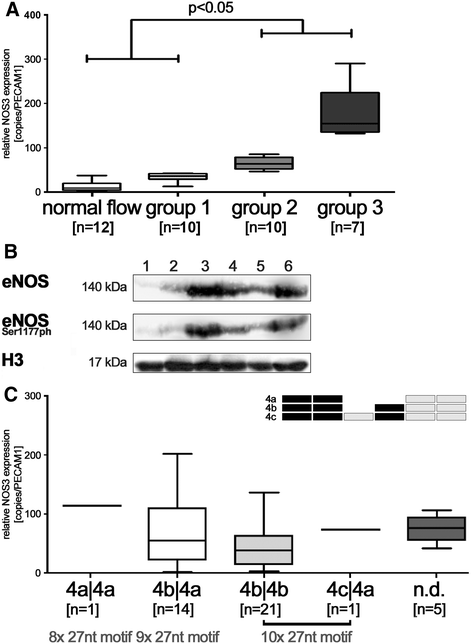
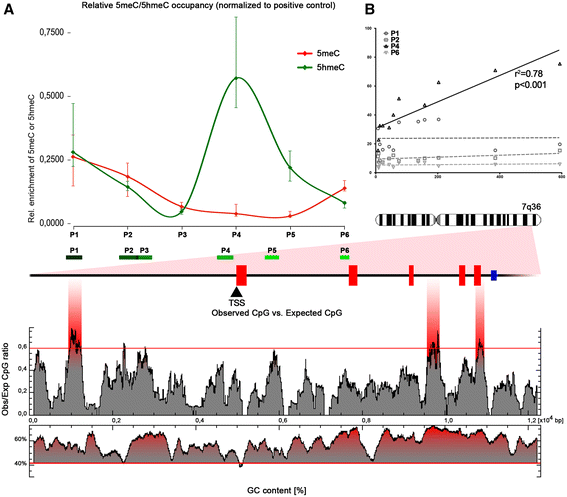
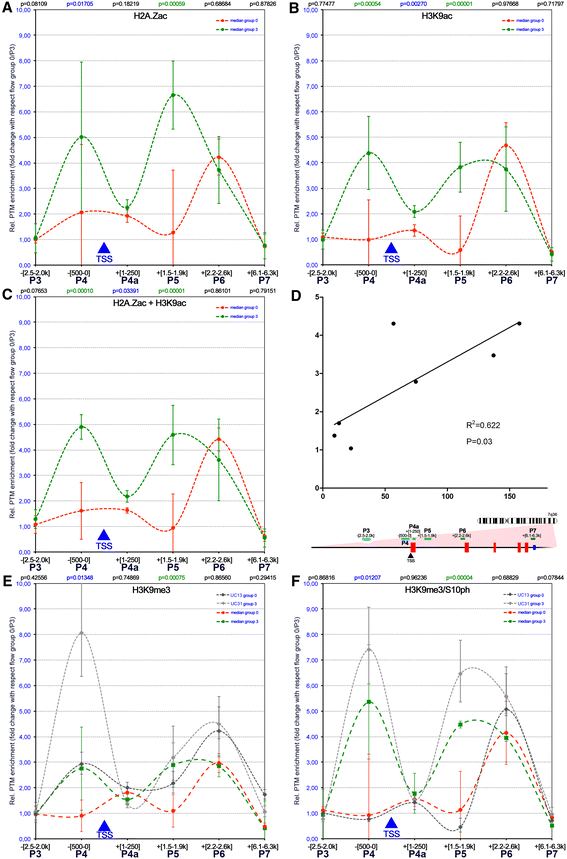

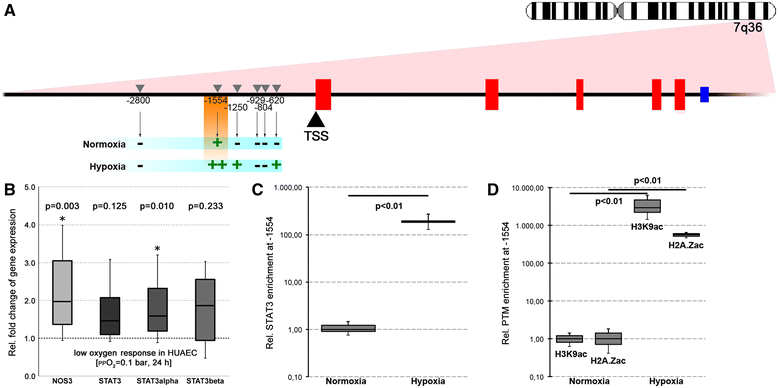
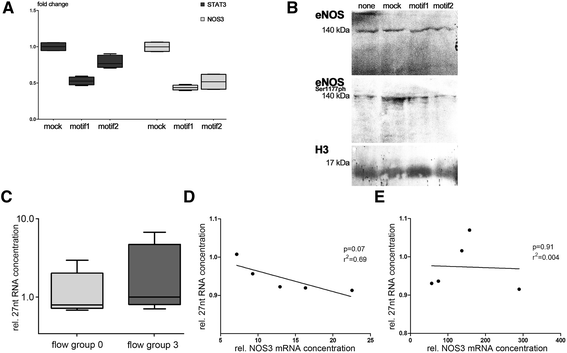
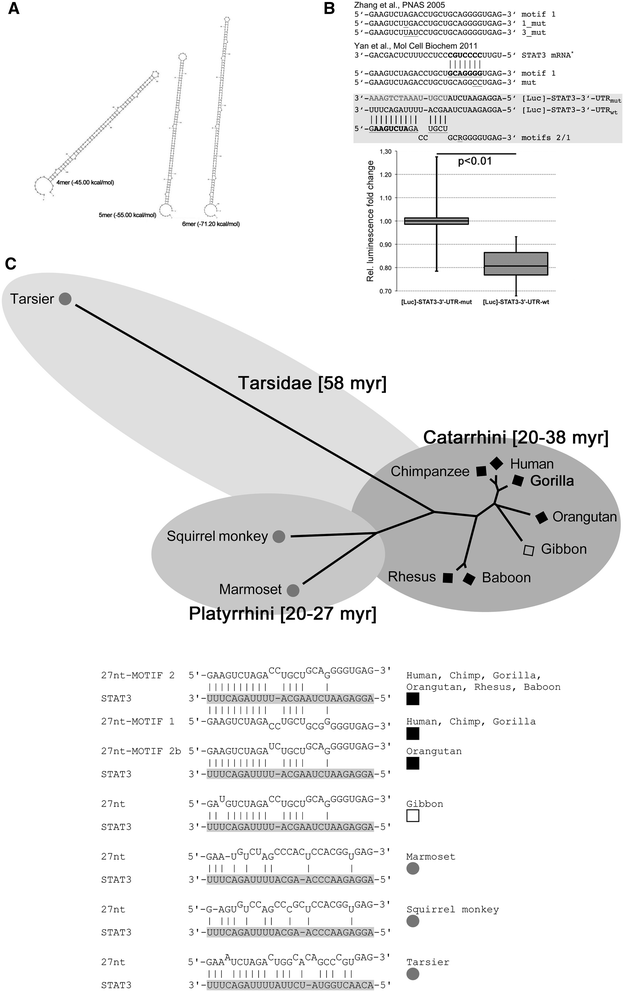
Similar articles
-
Neonatal exposure to hyperoxia leads to persistent disturbances in pulmonary histone signatures associated with NOS3 and STAT3 in a mouse model.Clin Epigenetics. 2018 Mar 20;10:37. doi: 10.1186/s13148-018-0469-0. eCollection 2018. Clin Epigenetics. 2018. PMID: 29581793 Free PMC article.
-
Involvement of NOS3 in RA-Induced neural differentiation of human NT2/D1 cells.J Neurosci Res. 2012 Dec;90(12):2362-77. doi: 10.1002/jnr.23118. Epub 2012 Sep 18. J Neurosci Res. 2012. PMID: 22987726
-
Insulin-dependent transcriptional control in L6 rat myotubes is associated with modulation of histone acetylation and accumulation of the histone variant H2A.Z in the proximity of the transcriptional start site.Biochem Cell Biol. 2014 Feb;92(1):61-7. doi: 10.1139/bcb-2013-0071. Epub 2013 Nov 4. Biochem Cell Biol. 2014. PMID: 24471919
-
Regulation of the MIR155 host gene in physiological and pathological processes.Gene. 2013 Dec 10;532(1):1-12. doi: 10.1016/j.gene.2012.12.009. Epub 2012 Dec 14. Gene. 2013. PMID: 23246696 Review.
-
Epigenetic landscape of amphetamine and methamphetamine addiction in rodents.Epigenetics. 2015;10(7):574-80. doi: 10.1080/15592294.2015.1055441. Epigenetics. 2015. PMID: 26023847 Free PMC article. Review.
Cited by
-
Epigenetic modifications in the development of bronchopulmonary dysplasia: a review.Pediatr Res. 2024 Aug;96(3):632-642. doi: 10.1038/s41390-024-03167-7. Epub 2024 Apr 3. Pediatr Res. 2024. PMID: 38570557 Review.
-
N-Acetylcysteine, a glutathione precursor, reverts vascular dysfunction and endothelial epigenetic programming in intrauterine growth restricted guinea pigs.J Physiol. 2017 Feb 15;595(4):1077-1092. doi: 10.1113/JP273396. Epub 2016 Dec 4. J Physiol. 2017. PMID: 27739590 Free PMC article.
-
Premature Vascular Aging in Guinea Pigs Affected by Fetal Growth Restriction.Int J Mol Sci. 2019 Jul 15;20(14):3474. doi: 10.3390/ijms20143474. Int J Mol Sci. 2019. PMID: 31311132 Free PMC article.
-
Downregulation of MicroRNA-152 contributes to high expression of DKK1 in multiple myeloma.RNA Biol. 2015;12(12):1314-22. doi: 10.1080/15476286.2015.1094600. RNA Biol. 2015. PMID: 26400224 Free PMC article.
-
Early Life Stress and Epigenetics in Late-onset Alzheimer's Dementia: A Systematic Review.Curr Genomics. 2018 Nov;19(7):522-602. doi: 10.2174/1389202919666171229145156. Curr Genomics. 2018. PMID: 30386171 Free PMC article. Review.
References
-
- Doi A, Park IH, Wen B, Murakami P, Aryee MJ, Irizarry R, et al. Differential methylation of tissue- and cancer-specific CpG island shores distinguishes human induced pluripotent stem cells, embryonic stem cells and fibroblasts. Nat Genet. 2009;41(12):1350–3. doi: 10.1038/ng.471. - DOI - PMC - PubMed
LinkOut - more resources
Full Text Sources
Other Literature Sources
Research Materials
Miscellaneous

